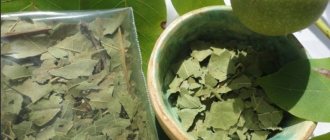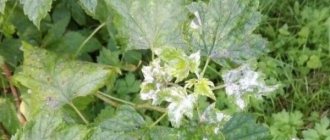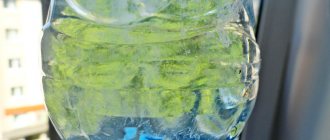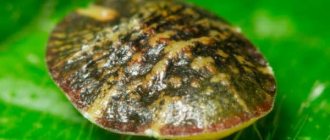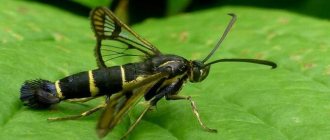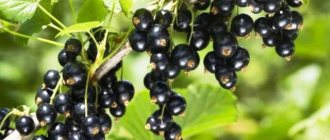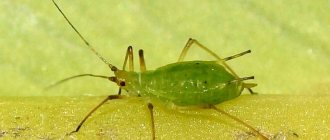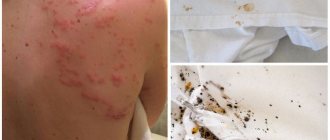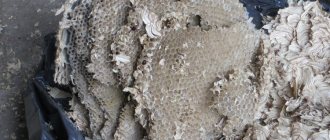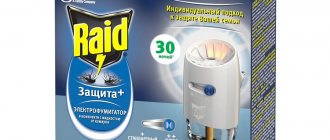Currant (currant) bud mite is the most dangerous pest of black currants. It can not only leave you without a harvest, but also cause weakening and death of plants. It is important to fight it in time and choose the right medications.
- Signs of plant damage by currant mite
- How dangerous are bud mites for plants?
- How to protect your garden from bud mites
- Measures to combat kidney mites
- Preparations against bud mites Spring treatments against bud mites
- Treatments against bud mite after harvest
Signs of pest damage
At different times of the year, seasonal signs of infection can be recognized on currants.
In spring and summer
The leaves of annual shoots acquire light shades, their surface becomes rougher, and at the top they become smaller and curly. Shoot growth stops. Multiple thin shoots of a reddish color appear, similar in shape to a broom, which do not bloom or bear fruit, but consume a lot of nutrients and gradually deplete the plant. The etiology of this pathological process is fungal or viral invasion.
The disease is incurable and eventually the currant bush dies. The currant mite is the carrier of pathogenic microflora.
in autumn
The buds affected by the mite increase in volume, as if they are swollen, and look like a torn head of cabbage. They contain thousands of females, ready to lay eggs with the onset of spring.
Description
The body of the kidney mite is worm-shaped and white. Females are about 0.3 mm long, and males are shorter - about 0.15 mm. The tick's head ends with a mouthpart similar to a wedge-shaped proboscis. The insect has two pairs of legs with feathery bristles. Tick larvae are elongated-oval, light in color.
The bud mite parasitizes black currants and gooseberries, but sometimes damages red and white currants. Ticks overwinter inside the kidneys, and one kidney can house from three to eight thousand individuals, and in large kidneys - from 8 to 30 thousand ticks. Buds occupied by a large number of pests appear larger and more convex. At the beginning of spring, they swell to the size of a pea and look like tiny heads of cabbage with deformed leaves sticking out. But those buds in which there are few ticks do not differ in appearance from healthy ones, and this makes it difficult to fight the pest.
Ticks spread both with planting material and with the help of wind, birds and other insects. Female ticks live from 20 to 45 days, each of them lays from 5 to 100 eggs. Eggs develop from one to two weeks, and larvae from one week to a month. The first generation of mites appears at the end of currant flowering. In one season, a tick produces five to six generations of offspring: two in spring and three in summer and autumn.
- Red gall aphids on currants - how to get rid of them, how to treat them
Measures to combat kidney mites
To get rid of the pest, diseased buds are removed from the bush, the plants are treated, and the rules of agricultural technology are followed. Control measures can be combined to increase their effectiveness.
Removing buds and shoots
In early spring (in the middle or second half of April), when enlarged buds are detected, infected shoots are cut and burned. After destroying the affected part of the plant, the bush produces new healthy growth. There are no pests in the soil.
Bush processing
Plant processing involves the use of folk remedies, biological and chemical preparations, among which organophosphorus compounds are isolated due to their high toxicity.
Folk remedies
Before the bushes begin to bud, the plant can be treated with hot water. The optimal temperature is +80 °C. One bucket of water is consumed per adult bush. This is one of the most affordable and safest ways to combat pests.
Currants are treated during the flowering period (second half of May) and after it with a lime-sulfur solution or a solution of colloidal sulfur suspension, for which 75 g of the suspension is dissolved in 10 liters of water.
Common folk remedies for treating the plant are infusions (the ingredients are mixed with 10 liters of water):
| Name of the infusion | Ingredients | Infusion time, hours |
| Garlic | 200 g minced garlic | 3 |
| Mustards | 200 g mustard powder | 8 |
| Dandelion | 200 g roots and 50 g leaves, minced in a meat grinder | 2 (stirring) |
Before use, the infusions are filtered.
Chemicals
The use of acaricides or insectoacaricides (Apollo, Kontos) is allowed. Spraying is carried out at intervals of 10 days two or three times. The air temperature should be above +5 °C with low air humidity and no wind. The last one is during the budding period.
Organophosphorus compounds
Organophosphorus agents (Phosfamide, Nitrafen) are allowed to be used only after harvesting.
Biological drugs
Biological agents (Fitoverm, Aktofit) are effective at temperatures above +19 °C in dry air and calm air. It is recommended to carry out three treatments with an interval of seven days. It is useful to alternate and combine biological products with biofungicides.
In autumn, bushes are sprayed with any acaricides.
Life cycle of a tick
As soon as the average daily spring air temperature reaches 5°C, egg laying begins inside the young buds. This process is irregular and lasts 3–6 weeks. During this time, females manage to lay 5–100 eggs. The embryonic development of the eggs lasts 3–15 days, then larvae emerge from them. The nymph stage lasts 10–14 days.
The emergence of the first generation of adult mites coincides with the beginning of currant flowering . With the emergence of a new population inside the kidneys, there are more and more of them. Each bud can contain several females with offspring. A small pest can be clearly seen on a cut only under a microscope .
This is the main problem of timely diagnosis of infection. It is often determined only by external signs on the plant or at the time of mite migration to new places.
When there is a shortage of food, mites quickly move upward along the shoots and colonize new developing buds on young growth. They can reach the top of the bush in 1–2 days. A large number of mites accumulate on the surface of the kidneys in the form of a white coating . When the weather worsens and the air temperature drops, migration stops, and the ticks hide in the bud scales and cracks in the bark.
In winter, bud mites enter a state of diapause and spend this time inside the buds. Depending on the weather, 3–6 generations of the pest appear in just one season.
Prevention of tick-borne infestation
To avoid or minimize damage from ticks, you should follow simple rules:
- Plant seedlings in compliance with the recommended distance for them, avoiding thickening.
- Avoid proximity to gooseberries, which are also often attacked by mites.
- Carry out pre-planting treatment of seedlings: by soaking in water at a temperature of +45 °C for 15 minutes;
- Actovertin (10 g per 10 l of water) or Colloidal sulfur (40 g per 10 l of water) for 20 hours.
Protect the environment
The fight against bud mites causes big problems for gardeners. However, proper care of currants and implementation of preventive measures can significantly reduce the possibility of crop loss. Most measures can protect crops from mites, harmful insects, and various diseases.
Do not forget that nature itself has invented a way to get rid of pests.
In the surrounding world, each parasite has its own natural enemies, entomophages, which successfully reduce its number. It is necessary to be attentive to small workers in gardens and vegetable gardens and to use chemicals carefully.
Insects that help fight mites are ladybirds, lacewings, carnivorous bugs, parasites (chalcids), hoverflies, encarsia wasps, phytoseiulus (predatory mites), etc.
Mr. Summer Resident recommends: mite-resistant currant varieties
Breeders have developed currant varieties resistant to bud mite:
| Name | Ripening time | Description |
| curiosity | Early ripening | It is characterized by high yield and resistance to frost. Needs frequent watering. The berries are oval, sweetish-sour with a thick skin. |
| Selechenskaya | Frost-resistant and drought-resistant. The fruits are large, glossy, black, sweet, with thin skin, weighing up to 5 g. | |
| Kipiana | Mid-late | The berries are black, medium-sized, sweetish-sour. |
| Vigorous | Late ripening | The fruits are oval, large (weighing up to 8 g), refreshingly sour. Needs systematic pruning. |
Optimal development conditions
The bud mite begins to “wake up” when the air temperature steadily warms up to +5 C without frost. Intense sap flow enhances bud growth, increasing the feeding area for mites.
At +12 C their migration to other bushes begins, so during the spring season the currant mite can infect the entire garden. In the autumn, in warm regions until November, the insect migrates from eaten away bushes that are unsuitable for food. Closer to frost, it finds a whole plant and hides in the buds for wintering.
How to expel the spider pest when the currants are already ripening
If the currant ovary occurred successfully and on time, and traces of spider mites are rare, then there is no point in radically fighting the pest at this stage - it is enough to stop further growth of the population.
- The same intensive watering of the currant bush will help with this - washing it off with water will inhibit the active reproduction of pest colonies on the berry.
- Abundant irrigation of currants followed by temporary wrapping of the bush in film will similarly reduce the number of berry parasites.
- The same turpentine or ammonia in open small containers around a mite-infested bush, covered for a short period with film, can also kill a fair number of larvae and adult insects.
- Regular inspection of currants and plucking off foliage occupied by the spider mite family will prevent the infection from growing and spreading to the ripening berry bunches.
Important! When such means do not stop the mite horde from further damage, then you can resort to biological products - the use of chemical poisons on ripening currants is undesirable.
Preventive measures
Prevention measures aimed at creating conditions unfavorable for ticks will become more effective and less costly.
To do this you need to follow some simple steps:
- from time to time destroy weeds on the site;
- collection and disposal of fallen leaves;
- use healthy planting material for propagation;
- increase the immunity of currants by applying fertilizers;
- digging up the soil around the bushes.
Start fighting ticks immediately after detecting traces of their presence. Delay and indecisiveness will lead to massive damage to bushes and loss of crops. Act methodically and consistently. By applying our recommendations, you can keep your currants healthy, even if ticks are rampant at your neighbors’ dacha.
The use of chemicals and other drugs to destroy the currant bud mite
The following methods for exterminating currant bud mites are not safe for the owner, his family, pets and birds. Therefore, before starting to use pesticides to kill ticks, it is necessary to carefully prepare, study the action and aftereffects of the chemical, its effectiveness, repeated use and technical recommendations in the specialized literature.
Frequency of treatments
If the instructions for use of the drug are violated, its effectiveness can be reduced to zero.
The development cycle of the currant bud mite depends on external temperatures. The first active development of currant bud mite larvae begins at an air temperature of +10..+12 °C, but their emergence and migration may occur after 25 days, until the air warms up to +18 °C. The higher the air temperature rises, the shorter the period of development from the egg of a carnivorous larva, which will infect new buds on the native and neighboring bushes (Table 1).
Table 1. Treatment intervals with drugs against currant bud mite
| Air temperature, °C | Development period, days | Treatment interval, days |
| +12..+18 | 25-30 | 8-12 |
| +20 | 20 | 10 |
| +25 | 10 | 5 |
| +30 | 6 | 3 |
The number of treatments in the temperature range must be at least three:
- the first treatment destroys overwintered adult female currant bud mites and hatched larvae (cold-resistant). Some eggs do not have time to go through the development cycle;
- with the onset of warmth, the second wave of larvae completes the development cycle. If you do not maintain the treatment interval (if you are late in treating the bushes), the larvae have time to turn into adult ticks and lay a second clutch of eggs.
- the third treatment is safety. The surviving young females of the currant bud mite can lay eggs, which will give rise to a new outbreak of infection of the bushes.
It is especially important to record the first migration of currant bud mite larvae. During this period they are visible to the naked eye. After treating the bushes, monitor the temperature in the future and observe the treatment interval. For example: the temperature is maintained in the range of +20..25 °C – the treatment interval is 8-10 days.
Currant buds affected by currant bud mite. © Christina
Causes
From year to year, the number of spider mites is not the same, since their development and reproduction require certain conditions. The appearance of spider mites is due to the following reasons:
- Hot and dry weather. It is under such conditions that the mass birth of larvae occurs, which soon become adult insects. If cold snaps occur in the summer, the tick can easily wait them out.
- There is a lack of nutrients in the soil. Due to a lack of certain organic components and minerals in the soil, a general weakening of currant bushes occurs. Pests will definitely take advantage of this, since they primarily harm weakened plants.
- Infection of currants from other plants in the garden. If there is a plant infected with a mite next to a currant bush, after a short period of time the pest will move to a healthy bush.
- Dust settled on currant leaves. Heavily dusty plants are an excellent habitat for mites. In this regard, it is recommended to water currants weekly using the sprinkling method. Water will wash away dust from the sheet plates.
